RENAULT MEGANE RS 2012 X95 / 3.G Owners Manual
Manufacturer: RENAULT, Model Year: 2012, Model line: MEGANE RS, Model: RENAULT MEGANE RS 2012 X95 / 3.GPages: 239, PDF Size: 9.2 MB
Page 191 of 239

JauneNoirNoir texte
5.19
ENG_UD18877_3
Feux arrière et latéraux : remplacement des lampes (X95 - B95 - D\
95 - Renault)
ENG_NU_837-6_BDK95_Renault_5
rear lIghts anD InDIcatOr lIghts: changing bulbs (5/6)
28
29
side light and brake light 28
Bulb type: P21/5w .
Direction indicator lights 29
Bulb type: Py21w .estate versions(continued)
Brake and side lights/direction
indicator lights
– Unclip covers 25 to access the nuts;
– unscrew the 2 nuts;
– from the outside, pull the light to -
wards you;
– remove the bulb holder 27 by releas-
ing the clips 26.
25
27
26
Page 192 of 239
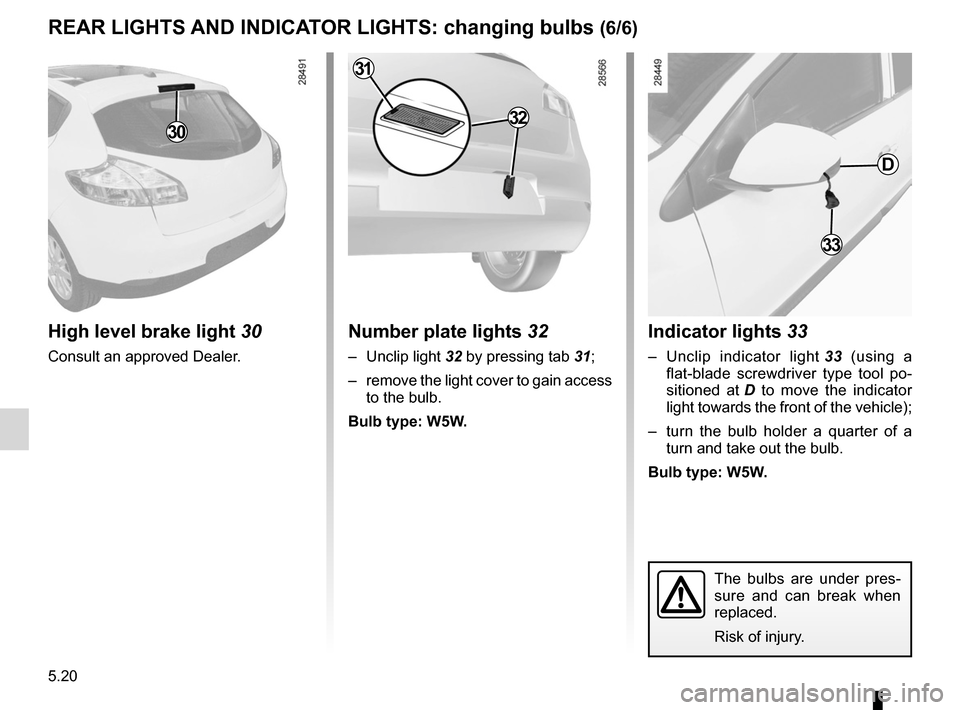
side indicator lightschanging bulbs ................................................. (current page)
lights: number plate lights .......................................... (current page)
5.20
ENG_UD18877_3
Feux arrière et latéraux : remplacement des lampes (X95 - B95 - D\
95 - Renault)
ENG_NU_837-6_BDK95_Renault_5
Rear lights (changing bulbs)
rear lIghts anD InDIcatOr lIghts: changing bulbs (6/6)
Indicator lights 33
– Unclip indicator light 33 (using a
flat-blade screwdriver type tool po -
sitioned at D to move the indicator
light towards the front of the vehicle);
– turn the bulb holder a quarter of a
turn and take out the bulb.
Bulb type: w5w .
number plate lights 32
– Unclip light 32 by pressing tab 31;
– remove the light cover to gain access
to the bulb.
Bulb type: w5w .
high level brake light 30
Consult an approved Dealer.
30
22
2333
D
32
31
The bulbs are under pres -
sure and can break when
replaced.
Risk of injury.
Page 193 of 239
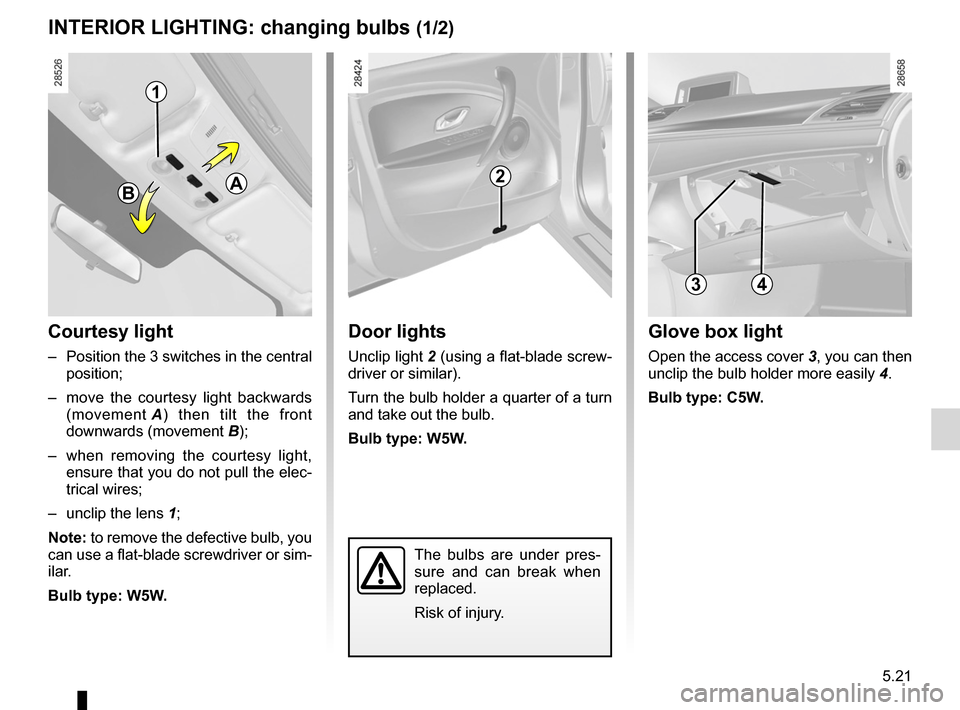
courtesy light ........................................ (up to the end of the DU)
lighting: interior ............................................. (up to the end of the DU)
5.21
ENG_UD17364_2
Eclairage intérieur : remplacement des lampes (X95 - B95 - D95 - Ren\
ault)
ENG_NU_837-6_BDK95_Renault_5
Interior lights (changing bulbs)
The bulbs are under pres -
sure and can break when
replaced.
Risk of injury.
InterIOr lIghtIng: changing bulbs (1/2)
courtesy light
– Position the 3 switches in the central
position;
– move the courtesy light backwards
(movement A ) then tilt the front
downwards (movement B);
– when removing the courtesy light,
ensure that you do not pull the elec-
trical wires;
– unclip the lens 1;
note: to remove the defective bulb, you
can use a flat-blade screwdriver or sim-
ilar.
Bulb type: w5w .
glove box light
Open the access cover 3, you can then
unclip the bulb holder more easily 4.
Bulb type: c5w .
Door lights
Unclip light 2 (using a flat-blade screw-
driver or similar).
Turn the bulb holder a quarter of a turn
and take out the bulb.
Bulb type: w5w .
2
4
Ba
3
1
Page 194 of 239
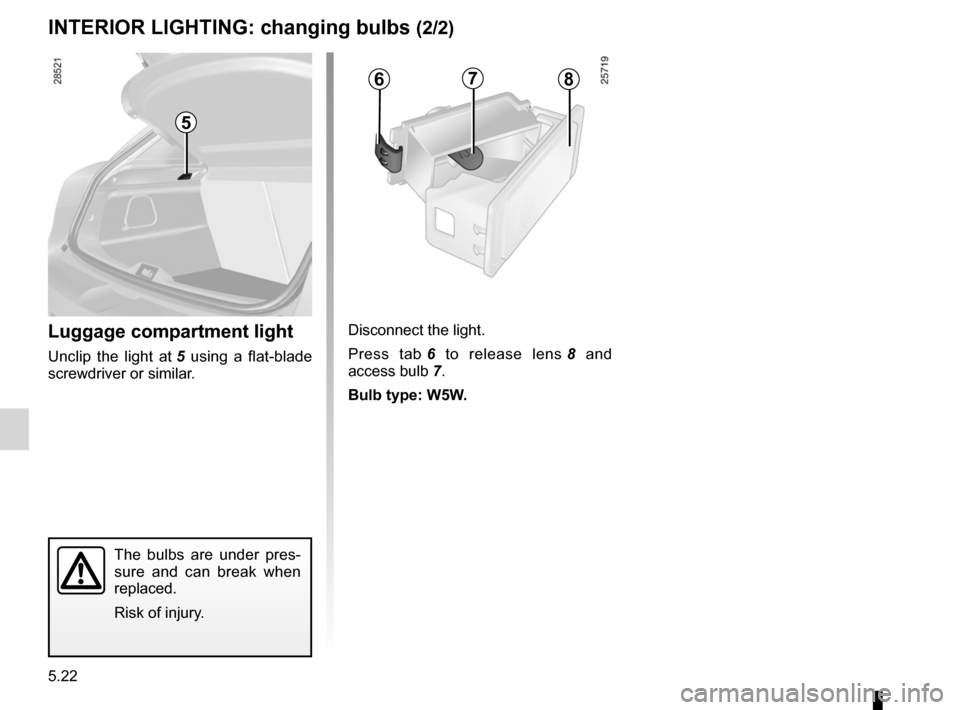
5.22
ENG_UD17364_2
Eclairage intérieur : remplacement des lampes (X95 - B95 - D95 - Ren\
ault)
ENG_NU_837-6_BDK95_Renault_5
The bulbs are under pres -
sure and can break when
replaced.
Risk of injury.
luggage compartment light
Unclip the light at 5 using a flat-blade
screwdriver or similar. Disconnect the light.
Press tab
6 to release lens 8 and
access bulb 7.
Bulb type: w5w .
InterIOr lIghtIng: changing bulbs (2/2)
5
678
Page 195 of 239
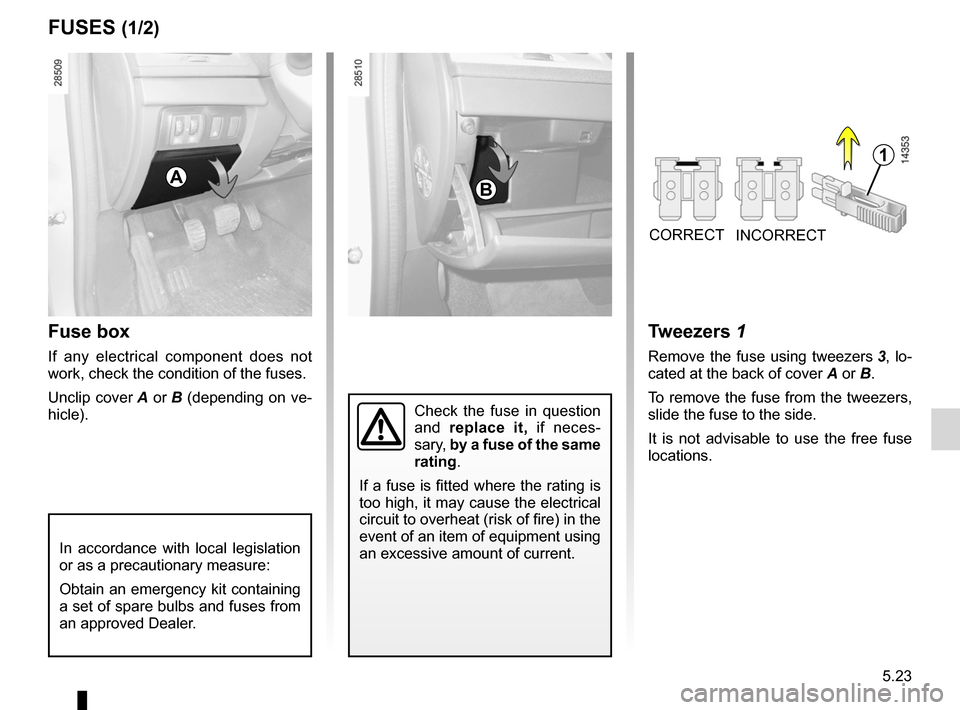
fuses ..................................................... (up to the end of the DU)
5.23
ENG_UD14417_2
Fusibles (X95 - B95 - D95 - Renault)
ENG_NU_837-6_BDK95_Renault_5
Fuse box
If any electrical component does not
work, check the condition of the fuses.
Unclip cover A or B (depending on ve-
hicle).
t weezers 1
Remove the fuse using tweezers 3, lo-
cated at the back of cover A or B.
To remove the fuse from the tweezers,
slide the fuse to the side.
It is not advisable to use the free fuse
locations.
Fuses
INCORRECT
CORRECT
Check the fuse in question
and
replace it, if neces-
sary, by a fuse of the same
rating.
If a fuse is fitted where the rating is
too high, it may cause the electrical
circuit to overheat (risk of fire) in the
event of an item of equipment using
an excessive amount of current.
Fuses (1/2)
1
aB
In accordance with local legislation
or as a precautionary measure:
Obtain an emergency kit containing
a set of spare bulbs and fuses from
an approved Dealer.
Page 196 of 239
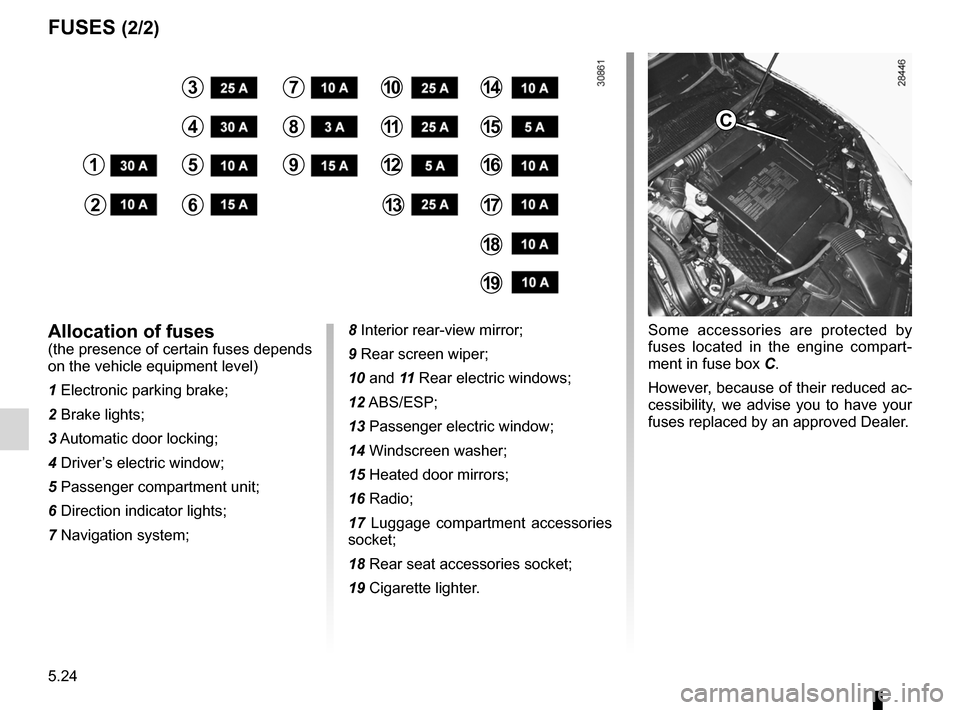
5.24
ENG_UD14417_2
Fusibles (X95 - B95 - D95 - Renault)
ENG_NU_837-6_BDK95_Renault_5
Fuses (2/2)
Some accessories are protected by
fuses located in the engine compart -
ment in fuse box C.
However, because of their reduced ac-
cessibility, we advise you to have your
fuses replaced by an approved Dealer.allocation of fuses(the presence of certain fuses depends
on the vehicle equipment level)
1 Electronic parking brake;
2 Brake lights;
3 Automatic door locking;
4 Driver’s electric window;
5 Passenger compartment unit;
6 Direction indicator lights;
7 Navigation system; 8 Interior rear-view mirror;
9 Rear screen wiper;
10 and 11 Rear electric windows;
12 ABS/ESP;
13 Passenger electric window;
14 Windscreen washer;
15 Heated door mirrors;
16 Radio;
17
Luggage compartment accessories
socket;
18 Rear seat accessories socket;
19 Cigarette lighter.
c
1
2
3
4
5
6
7
8
9
10
11
12
13
14
15
16
17
18
19
Page 197 of 239

batterytroubleshooting ............................... (up to the end of the DU)
5.25
ENG_UD9611_2
Batterie : dépannage (X95 - B95 - D95 - Renault)
ENG_NU_837-6_BDK95_Renault_5
Battery
Battery: troubleshooting (1/2)
to avoid all risk of sparks:
– Ensure that any electrical consumers
(courtesy lights, etc.) are switched
off before disconnecting or recon -
necting the battery.
– When charging, stop the charger
before connecting or disconnecting
the battery.
– Do not place metal objects on the
battery to avoid creating a short cir-
cuit between the terminals.
– Always wait at least one minute after
the engine has been switched off
before disconnecting a battery.
– Make sure that you reconnect the
battery terminals after refitting.
connecting a battery charger
the battery charger must be com -
patible with a battery with nominal
voltage of 12 volts.
Do not disconnect the battery when the
engine is running. Follow the instruc-
tions given by the manufacturer of
the battery charger you are using.
Special procedures may be
required to charge some
batteries. Contact your ap -
proved dealer.
Avoid all risk of sparks which may
cause an immediate explosion, and
charge the battery in a well-venti -
lated area. Risk of serious injury.
Handle the battery with care
as it contains sulphuric acid,
which must not come into
contact with eyes or skin. If
it does, wash the affected area with
plenty of cold water. If necessary,
consult a doctor.
Ensure that naked flames, red hot
objects and sparks do not come into
contact with the battery as there is a
risk of explosion.
The engine may be hot when car -
rying out operations in close prox -
imity. In addition, the engine cooling
fan can come on at any moment.
Risk of injury.
Page 198 of 239
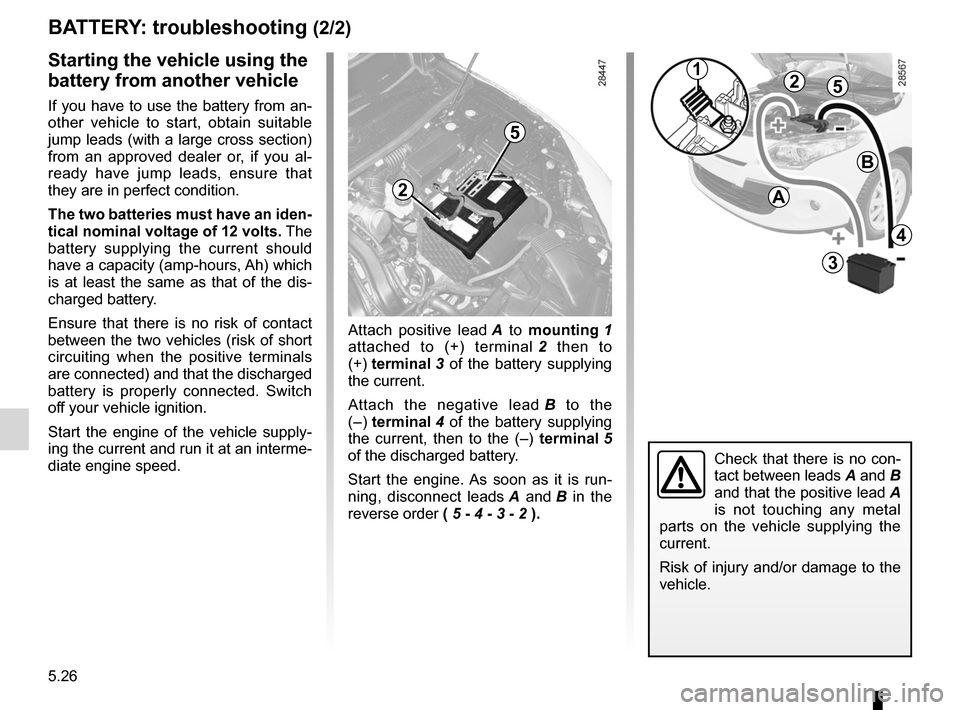
5.26
ENG_UD9611_2
Batterie : dépannage (X95 - B95 - D95 - Renault)
ENG_NU_837-6_BDK95_Renault_5
Attach positive lead A to mounting 1
attached to (+) terminal 2 then to
(+) terminal 3 of the battery supplying
the current.
Attach the negative lead B to the
(– ) terminal 4 of the battery supplying
the current, then to the (–) terminal 5
of the discharged battery.
Start the engine. As soon as it is run -
ning, disconnect leads A and B in the
reverse order ( 5 - 4 - 3 - 2 ).
starting the vehicle using the
battery from another vehicle
If you have to use the battery from an-
other vehicle to start, obtain suitable
jump leads (with a large cross section)
from an approved dealer or, if you al -
ready have jump leads, ensure that
they are in perfect condition.
the two batteries must have an iden-
tical nominal voltage of 12 volts. The
battery supplying the current should
have a capacity (amp-hours, Ah) which
is at least the same as that of the dis-
charged battery.
Ensure that there is no risk of contact
between the two vehicles (risk of short
circuiting when the positive terminals
are connected) and that the discharged
battery is properly connected. Switch
off your vehicle ignition.
Start the engine of the vehicle supply -
ing the current and run it at an interme-
diate engine speed.
Battery: troubleshooting (2/2)
2
3
4
5
a
B
1
Check that there is no con-
tact between leads A and B
and that the positive lead A
is not touching any metal
parts on the vehicle supplying the
current.
Risk of injury and/or damage to the
vehicle.
2
5
Page 199 of 239
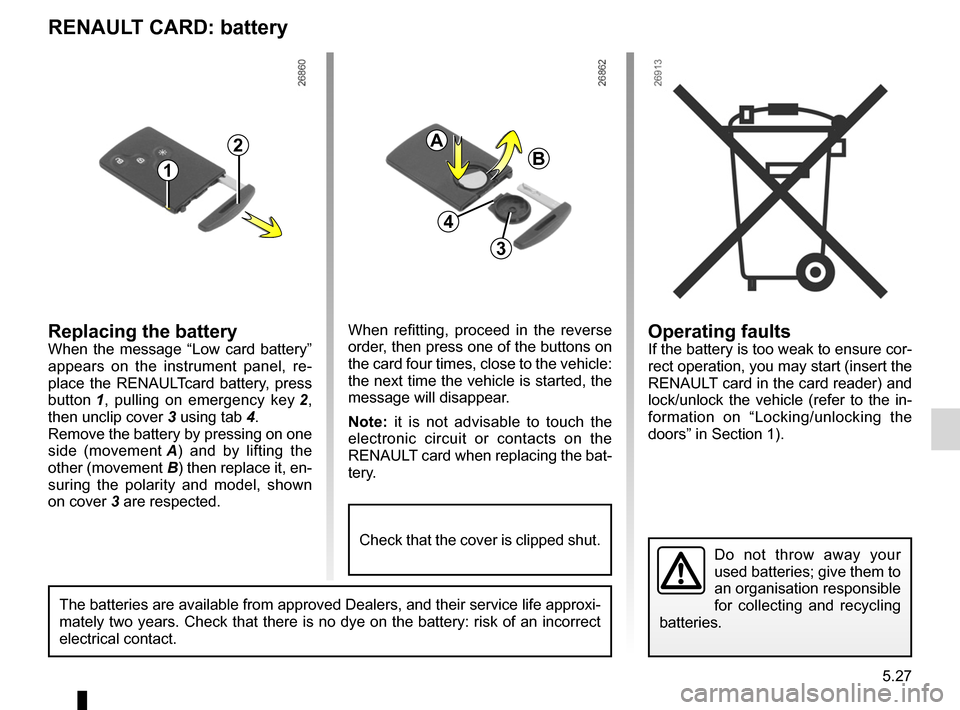
RENAULT cardbattery ............................................. (up to the end of the DU)
RENAULT card battery .........................(up to the end of the DU)
5.27
ENG_UD14060_2
Carte RENAULT : pile (X91 - B91 - K91 - Renault)
ENG_NU_837-6_BDK95_Renault_5
Operating faultsIf the battery is too weak to ensure cor-
rect operation, you may start (insert the
RENAULT card in the card reader) and
lock/unlock the vehicle (refer to the in-
formation on “Locking/unlocking the
doors” in Section 1).
RENAULT card: battery
renault carD: battery
replacing the batteryWhen the message “Low card battery”
appears on the instrument panel, re -
place the RENAULTcard battery, press
button 1 , pulling on emergency key 2 ,
then unclip cover 3 using tab 4.
Remove the battery by pressing on one
side (movement A ) and by lifting the
other (movement B) then replace it, en-
suring the polarity and model, shown
on cover 3 are respected.
Do not throw away your
used batteries; give them to
an organisation responsible
for collecting and recycling
batteries.
1
2
When refitting, proceed in the reverse
order, then press one of the buttons on
the card four times, close to the vehicle:
the next time the vehicle is started, the
message will disappear.
n ote: it is not advisable to touch the
electronic circuit or contacts on the
RENAULT card when replacing the bat-
tery.
a
B
3
The batteries are available from approved Dealers, and their service life approxi -
mately two years. Check that there is no dye on the battery: risk of an incorrect
electrical contact.
4
Check that the cover is clipped shut.
Page 200 of 239

fitting a radio ......................................... (up to the end of the DU)
speakers location ........................................... (up to the end of the DU)
radio fitting a radio ................................... (up to the end of the DU)
fitting a radio ......................................... (up to the end of the DU)
5.28
ENG_UD6351_1
Prééquipement radio (X95 - B95 - D95 - Renault)
ENG_NU_837-6_BDK95_Renault_5
Fitting a radio
FIttIng a raDIO
If your vehicle is not fitted with an audio
system, one can be fitted and locations
have been provided for:
– the radio 1;
– tweeter speakers 2;
– bass speakers 3.
To install any equipment, please con -
sult an approved dealer.
radio location 1Unclip the blanking cover. The aerial, +
and – supply and speaker wire connec -
tions are located behind it.
– In all cases, it is very important to follow the manufacturer’s instructions care-
fully.
– The specifications of the brackets and wires (available from our network) vary
depending on the equipment level of your vehicle and the type of radio.
Consult an approved Dealer to find out the correct part number.
– No work may be carried out on the vehicle’s electrical or radio circuits, except
by approved dealers: an incorrectly connected system may result in damage
being caused to the electrical equipment and/or the components connected to
it.
1
2
3